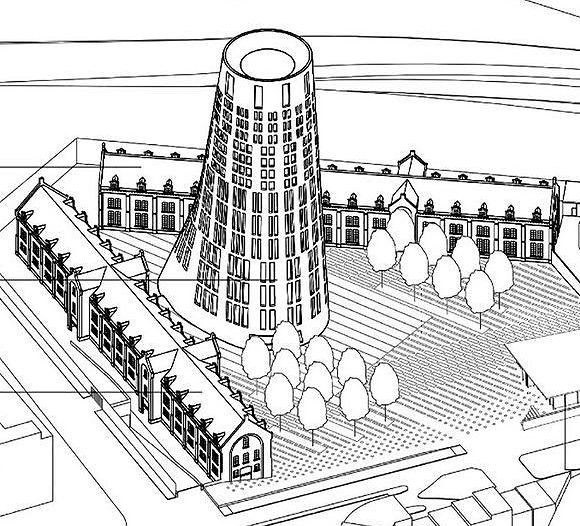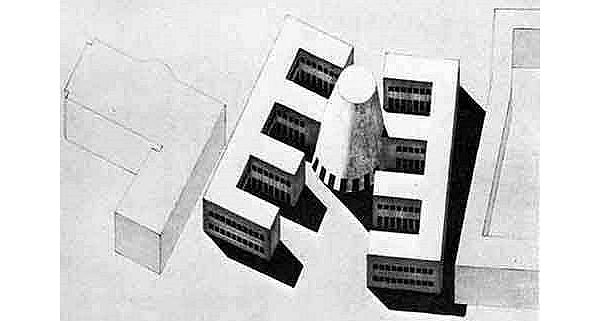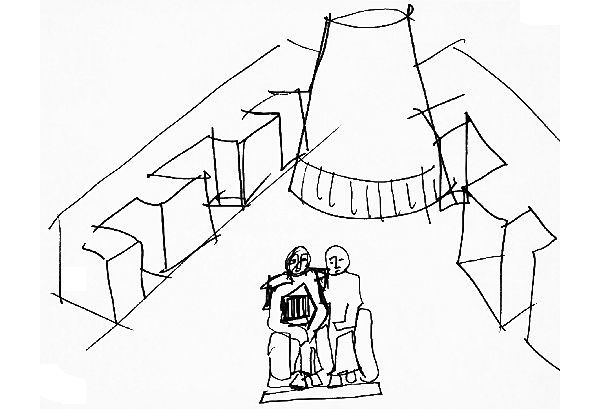2015.12.01 21:18
Let's talk about a building
Googled critique and quickly found these:
Critique is a method of disciplined, systematic analysis of a written or oral discourse. Although critique is commonly understood as fault finding and negative judgment, it can also involve merit recognition, and in the philosophical tradition it also means a methodical practice of doubt.
The terms critic, criticize, criticism have always had a double sense in English. The base meaning is “pass judgment on”, but in popular use the words have usually meant “pass a negative judgment on”, while in academic and literary use they have tended in the opposite direction, signifying close and dispassionate analysis which may or may not issue in a formal judgment.
The French version critique was adopted into English primarily as a noun, meaning an instance of criticism, a critical essay or notice; in many cases there is no evident distinction between critic(k) and critique in this sense until the 19th century. Around 1960 academics began using critique in both nominal and verbal senses more and more frequently—at a guess, as a desperate effort to drive into thick undergraduate heads the fact that the critical endeavor in literature, art, history and philosophy is not simply a matter of expressing negative opinions.
If that was the intention, it failed. Today critique in popular use is just as likely to mean ‘censure’ as ‘analyze’.
This thread contains a lot of 'censure' and little 'analyze'.
My first comment--I wonder if there's every any architectural criticism that winds up being more interesting than the criticized building itself--was made because the building remained much more interesting than any of the comments up to that point, except Nam's "Plus, while the tower may seem overbearing within the context of the other brick buildings from some views, within the context of the adjacent highway/slope it seems more appropriate somehow..." The stand-alone conical tower immediately reminded me of Rossi's many such designs, but I didn't want to mention it because the connection was just a similar shape. The whole design opened up however when Olaf posted this image:

"Wow, that's almost exactly Rossi's City Hall of Muggio (1972)."


As much as Nouvel's design is a homage to Rossi, it's also a typological exercise in formulating a civic architecture.
Designing civic architecture is interesting in that it has it's own type of scale and detailing. It's not domestic in scale and detailing, nor commercial. It's like a simplified grandeur, and the symbolism is also simplified. Hôtel de Police & Extension de Charleroi Danses is a really nice contemporary example of civic architecture.
ps If you take the time to look you'll find that, besides the police headquarters, this project/complex also includes expanded dance studios, housing for resident artists, and a brasserie.
| |
2015.12.02 12:25
Let's talk about a building
no one here is judging the building in person. We are all looking at images, all of which are abstractions of the reality. As an architect, I am able to judge (and design) architecture from all kinds of images and viewpoints; that's exactly what architects should be able to do. The biggest difference between the positive and negative critiques here is that virtually all the negative are almost purely reactionary (with the reactions then somewhat impulsively justified) , while the positive are the design more broadly considered.
2015.12.02 12:36
Let's talk about a building
I'm really curious. In what way are towers actually oppressive. How exactly is this oppression manifest (in the viewer)?
2015.12.02 17:50
Let's talk about a building
...you're relying on abstraction (e.g. 1:7 threshold) as much as anyone else here, and none of it means that anyone here has "lost touch with the humane experience of architecture as environment, and are in love with the abstractions and playthings of design communication." Plus, your implication that I "need a high abstraction layer or a bunch of drawings in order to appreciate the aesthetic value of a built work" is plainly untrue. You actually failed to recognize/understand my process of critique, which shows how your own "powers of perception" are not at all as good as you think they are.
To recap:
My first comment--I wonder if there's every any architectural criticism that winds up being more interesting than the criticized building itself--was made because the building remained much more interesting that any of the comments up to that point, except Nam's "Plus, while the tower may seem overbearing within the context of the other brick buildings from some views, within the context of the adjacent highway/slope it seems more appropriate somehow..." The stand-alone conical tower immediately reminded me of Rossi's many such designs, but I didn't want to mention it because the connection was just a similar shape.
My second comment--A refreshingly non-mediocre building. Somewhat the opposite of what most of the criticism here would like it to be.--was a result of looking at more photographic images of the building/project and reading the continual comments here. Looking at the building/project it became evident that it is almost entirely comprised of unconventional elements: the conical shape, the fenestration, the stark compositional contrast of horizontal wings and vertical shaft mixed with the complementary coloring of orange and blue. All hot or cold, nothing lukewarm, hence "a refreshingly non-mediocre building". Yet, in the comments, it is exactly all the unconventions that are negatively critiqued.
Then came the Rossi/City Hall of Muggio "a-ha" moment where I came to recognize how Nouvel was working along the lines of designing "an analogous city."
For whatever it's worth, right now, each time a look at photographs of the project it appears more and more attractive.
| |
2015.12.02 18:47
Let's talk about a building
No, I didn't miss your point. You just now changed your point to make it look like you've all along considered this project from a more broad perspective. Note, too, how I never commented on your view of the building. I was showing how you failed to understand my critique. You tried very hard to render my critique invalid, and I want it understood that you are wrong about my critique being invalid.
What you're really afraid of is that, if my critique is valid, then maybe your critique isn't. I don't have that fear because my critique is valid regardless of your critique.
2015.12.03 19:13
Futurist / Brutalist
In the future, all Gyms will be done in the Brutalist style.
2015.12.04 12:16
"Are we human?" Curators Beatriz Colomina and Mark Wigley announce concept for 2016 Istanbul Design Biennial
The conclusion of a discussion here "about the possibility of a virtual architectural biennale" from almost two years ago:
Orhan Ayyüce:
With "set piece" I meant representative pieces of architecture as in drawings, models of buildings already built or designed or under construction/slated. Versus, generation of ideas in architecture and urban design before any of that happens.
Quondam:
I really don't know Wigley, but fourteen years ago, he and I had a mostly private conversation over lunch (we both have a schizophrenic brother), and the next evening I sat next to him at a Zengelis/Gigantis Thankgiving dinner party. Plus we talked about bidding at eBay in the car that was giving me a ride back to my hotel--he was slightly upset by usually being outbid on items he wanted, and I teased him that I got that item. As I'm thinking back to those conversations, it's kind of refreshing how much I'm able to remember about them. I started our first conversation by telling him that (because I knew he too was going to be at the conference) I decided to read something written by him in case I might meet him. I read "Untitled: The Housing of Gender." I told him I had to stop reading it because it was making me uncomfortably question too many things about my own 'housing' and 'gender'. He broadly smiled in agreement because I seem to have gotten exactly what the essay was about. And from there we just started talking about all kinds of stuff.
In terms of set-piece or process, I'd say multiple choice as in:
column A
set-piece
process
column B
fertility
conception
assimilation
metabolism
pregnancy
osmosis
electromagnetism
all-frequency
column C
architecture
urbanism
The setting in the video reminded me of being in Australia--something about the light and the view in the background. Perhaps roughly the same distance from the Equator.
- - - - - - - -
2015.12.04
Note column B comprises the design operations of being human itself.
| |
2015.12.04 16:41
Let's talk about a building
"What you're really afraid of is that, if my critique is valid, then maybe your critique isn't. I don't have that fear because my critique is valid regardless of your critique."
Actually, I never accused you of anything because you disagree with me; your opinion about the building/project doesn't even matter to me. You're the one that set up the positive versus negative reviews, and in so doing misrepresented how the positive views operated. I corrected your false accusation.
Ask yourself why you even made such false accusations.
2015.12.04 20:07
Let's talk about a building
Also, I'm not sure you actually know the difference between an objective statement and a subjective statement. For example, "For whatever it's worth, right now, each time a look at photographs of the project it appears more and more attractive." is not a subjective statement. It's an objective account of what I have found to have occurred after each time I looked at pictures of the project. If I had said, "after looking at images of the project this is the most beautiful building in the world," that is a subjective statement.
2015.12.04 20:29
Let's talk about a building
attractive, as in, having qualities that arouse interest, pleasure, or affection.
The building/project continues to arouse my interest. There's nothing semantic or subjective about that.
2015.12.04 23:01
Let's talk about a building
What did the local police tell Nouvel that they wanted from their new building. What were their concerns? (What are the concerns of all the police in Belgium and Europe at this time in history?) Did the police speak of terrorist threats along with all the regular issues of law enforcement? Did Nouvel carefully consider what a police headquarters really means to this part of the world at this point in time?
I have a feeling that the design of this building/project actually reflects the concerns of the police and the local citizenry, as well as reflects Nouvel's consideration of all the concerns. [And when I have more time, here's where the notion of civic architecture, analogous city, and police presence in today's Belgium is discussed.]
Do the people that live around and near this project feel in any way safer because of this formidable police presence? I wonder.
2015.12.05 16:59
"Are we human?" Curators Beatriz Colomina and Mark Wigley announce concept for 2016 Istanbul Design Biennial
Cities are artificial, even uniquely artificial in that they don't imitate nature at all.
|